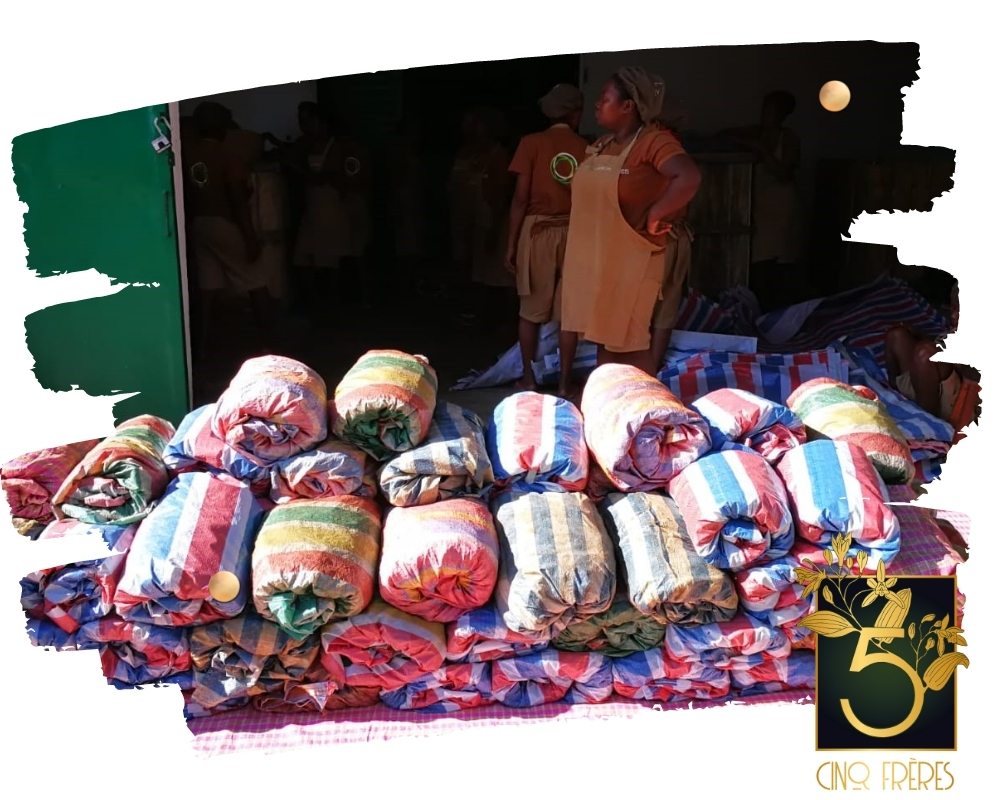Vanilla is a product that requires a lot of attention, whether for its cultivation or during the processing of the pods (harvested green, the pods give off very little odor. A process lasting several months is necessary for 'they reveal all their aromatic power, all their fragrances).
Supply
The “Cinq Frères” vanilla journey begins in the Sava region in northern Madagascar, a historical production area for this spice and often referred to as the Vanilla Capital of the World.
We have our own vanilla plantations there, located along the Ankavy River and work along with small local farmers

Plantation
The vanilla tree is a liana belonging to the Orchid family. Multiplied by cuttings, it takes 3 years for it to develop its first flowers.
At Cinq Frères, we are proud to cultivate our fields and manage our activities in a sustainable manner. In 2019 we thus obtained the Organic Agriculture certification from Ecocert and can offer certified vanilla without chemicals and traced to the field to our customers.
Pollination
Although established in Madagascar since the end of the 19th century, vanilla trees - originating in Mexico - do not have a natural pollinator on Île Rouge. Each flower must then be pollinated by hand.
The flowering being of a short timeframe (within a few hours), it is necessary to spend every morning in the fields to pollinate the flowers which bloomed.
A pollinated flower will give a pod.

Harvest
It is only after 8-9 months of growth that the pods can be harvested. Green in color with yellow tips when they approach maturity.
Since vanilla is a dehiscent fruit, the pods - which are actually capsules - split open when they reach full maturity. The pods must then be harvested, just before they are mature.
Although the vanilla pods grow in clusters, each develops at its own speed. It is therefore necessary to go through the fields on a daily basis to select only the pods which have reached the desired stage of maturity. It can neither be too early nor too late ...

Transport and reception green vanilla
The freshly harvested green vanilla pods are grouped together in “gony”, woven polypropylene bags, allowing them to be transported from one site to another while protecting them from possible contamination.
They are thus transported by canoe to the preparation store in Antalaha and weighed upon receipt.

Sorting pods
Upon receipt, the vanilla pods are sorted by size and stage of maturity. The short pods (<12 cm) are separated from the long ones and the slit ones are separated from the unsplit ones.
Pod washing
Once sorting is complete, the pods are washed in clean water, for safety, in order to get rid of any residues.
Scalding
The process of transforming green pods can finally begin.
The pods are placed in wicker baskets and scalded for 2 to 3 minutes in water heated to 63 ° C. The duration of scalding varies according to the size and stage of maturity of the pods. Il This key step has a dual objective:
- stop the vegetative phase of the pods in which they are still found and during which they continue to mature and can still split in two
- breaking the cellular structures of the pods in order to initiate the biochemical reactions necessary for the development of aromas.

Steaming
As soon as they leave the scalding, the pods are placed in a steaming box where they will spend 48 to 72 hours. Wrapped in several layers of cotton blankets, the objective is to maintain a temperature above 40 ° C, essential for the continuation of the enzymatic activity initiated during scalding.

Drying
The drying phase of vanilla lasts about 2 to 3 months and is divided into two stages. The first month is devoted to drying in the sun. The pods are exposed to the sun, for 2 to 3 hours daily. During the night, they are stored under blankets, in order to retain the heat.
As soon as the pods become flexible, they move on to a gentler drying phase, in the shade. Split pods are usually the first to be put on drying racks inside buildings.
Daily sorting is carried out throughout these drying phases to organize the pods according to their drying speed. Each at their own pace, they will get rid of part of their water and "stabilize". Refining can then begin.

Bulk sorting and refining in wooden boxes
The pods are sorted according to their apparent moisture content and stored in wooden boxes, covered with wax paper. The objective is now to limit the loss of water from the pods and to allow time for the aromas to develop. Indeed, if it is necessary to reduce the quantity of bioavailable water to prevent the development of fungi and other undesirable microorganisms, water also represents an essential substrate for the formation of aromatic molecules.

Classification and measurement
After a few weeks of ripening and once the pods have developed all their flavors, they are classified according to 3 main criteria which define the export grades:
- Their humidity *
- Their length
- Their splitting
* The moisture content is the main factor influencing the color and flexibility of the pods.

Gauging and storage
The gauging is the last step in the vanilla preparation process. Ready for export, the pods are again stored in wooden boxes, while waiting to be packaged and exported.

Packaging and conditioning of Gourmet Vanilla Beans at the store by the carrier
The conditioning is done at the last moment. The homogeneous boots are stacked in boxes with walls covered with paraffin paper. Once completed, the boxes are taped, filmed and sealed by a customs officer,. Ready to be shipped, they will take the road to the port of Antalaha or the airport of Sambava to leave the SAVA region and begin their journey to consumer.

